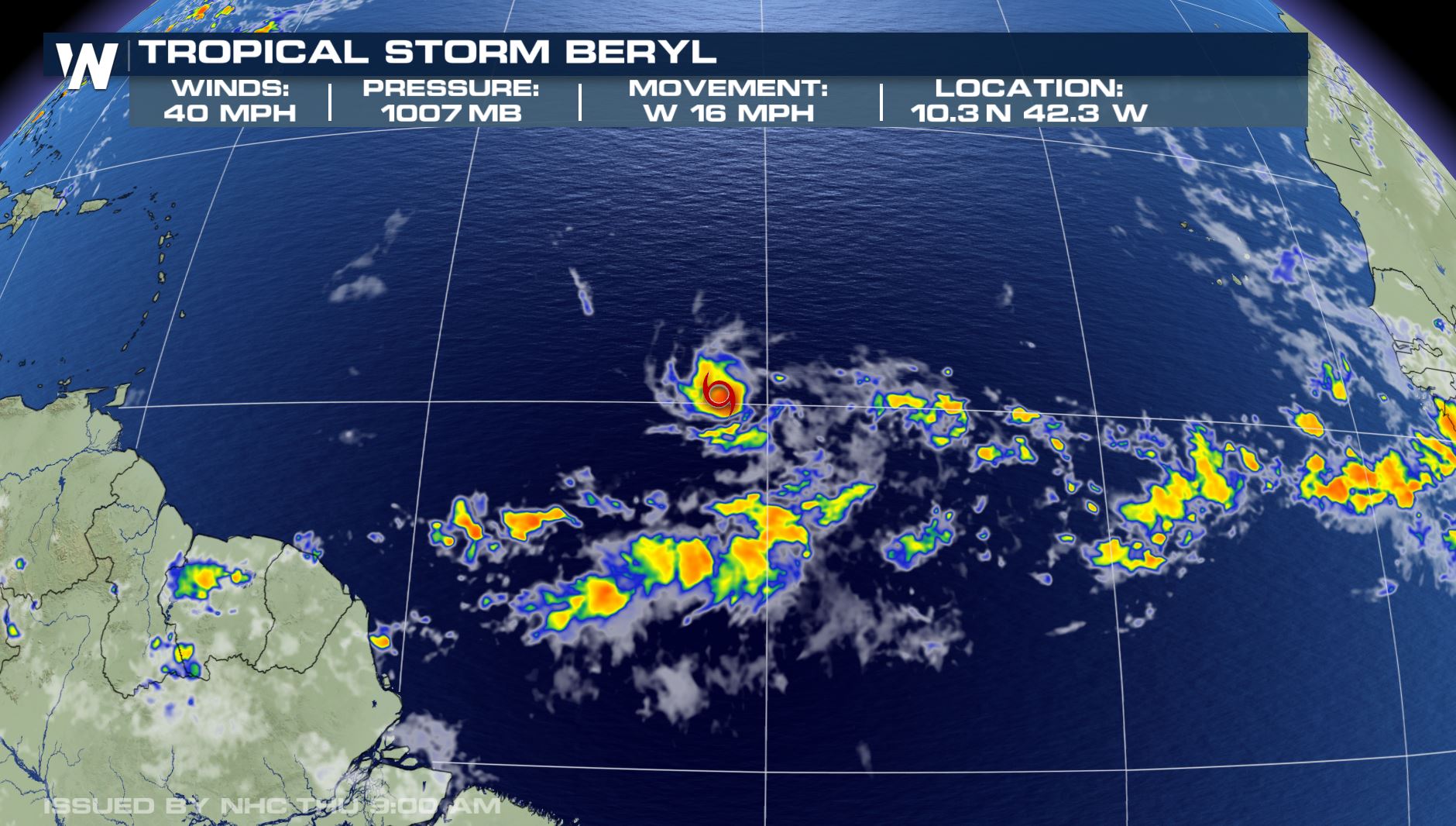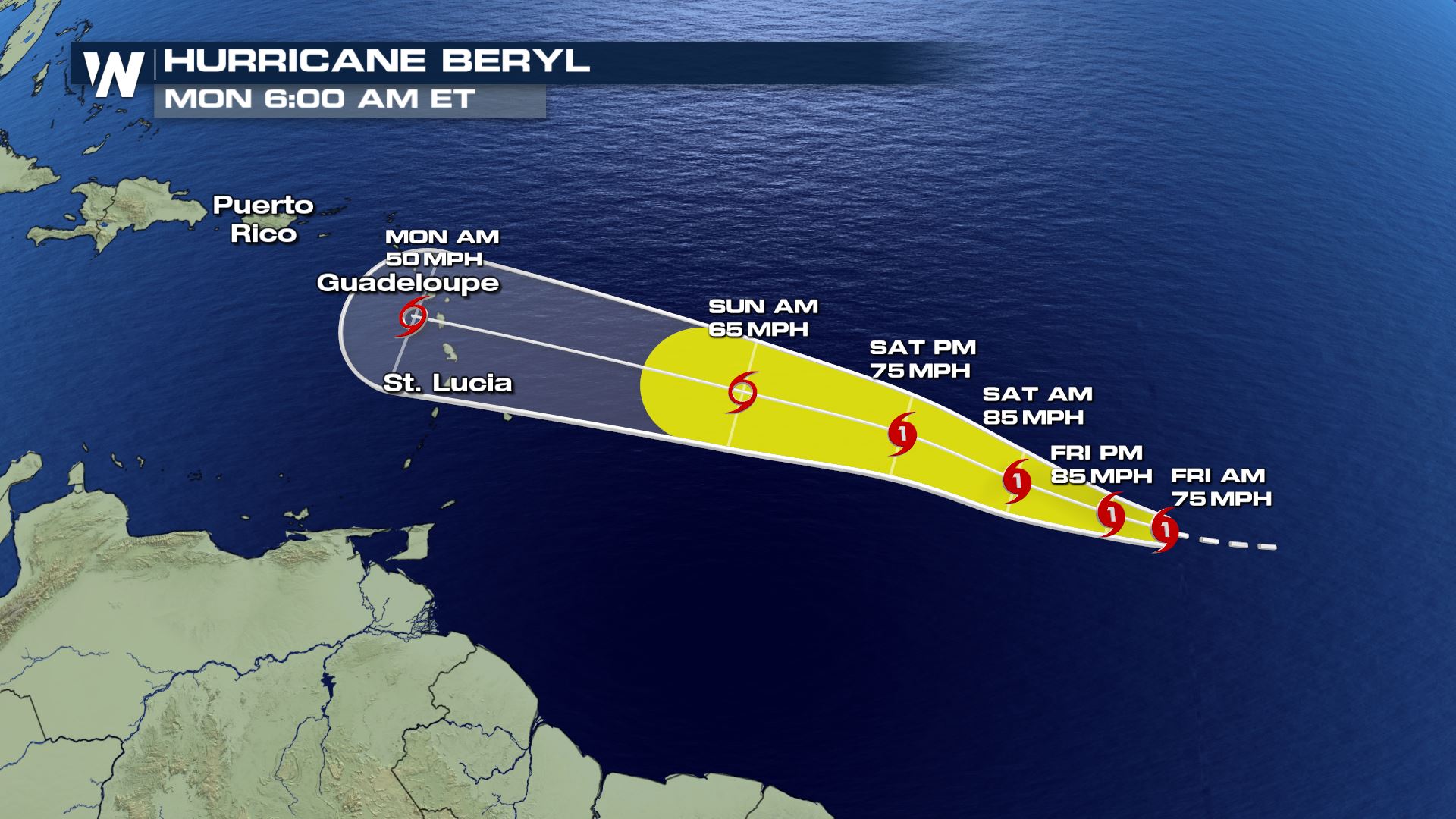Hurricane Beryl’s Path and Intensity Forecast

Hurricane Beryl, a Category 1 hurricane, is currently located in the western Atlantic Ocean, approximately 1,000 miles east of the Lesser Antilles. The hurricane is expected to move west-northwestward over the next few days, passing north of the Leeward Islands and Puerto Rico. Beryl is then forecast to turn northward and weaken to a tropical storm as it approaches the southeastern United States coast.
Several factors will influence the path and intensity of Hurricane Beryl. The hurricane is currently moving in response to the prevailing easterly trade winds. As Beryl approaches the Caribbean Sea, it will likely encounter stronger wind shear, which could weaken the hurricane. Additionally, the cooler waters of the North Atlantic Ocean could also contribute to Beryl’s weakening.
Current Location and Expected Trajectory
Hurricane Beryl is currently located at 15.5°N, 56.5°W, about 1,000 miles east of the Lesser Antilles. The hurricane is moving west-northwestward at 16 mph. The National Hurricane Center predicts that Beryl will continue to move west-northwestward over the next few days, passing north of the Leeward Islands and Puerto Rico. The hurricane is then forecast to turn northward and weaken to a tropical storm as it approaches the southeastern United States coast.
Factors Influencing Beryl’s Path and Intensity
Several factors will influence the path and intensity of Hurricane Beryl. The hurricane is currently moving in response to the prevailing easterly trade winds. As Beryl approaches the Caribbean Sea, it will likely encounter stronger wind shear, which could weaken the hurricane. Additionally, the cooler waters of the North Atlantic Ocean could also contribute to Beryl’s weakening.
Potential Impacts of Hurricane Beryl: Hurricane Beryl Forecast

Hurricane beryl forecast – Hurricane Beryl poses significant threats to coastal communities, inland regions, and offshore installations. Its potential impacts include storm surge, flooding, high winds, and power outages.
The areas most likely to be affected by Hurricane Beryl are coastal communities along the path of the storm. These communities are at risk of storm surge, flooding, and high winds. Inland regions can also be affected by flooding, high winds, and power outages. Offshore installations, such as oil rigs and wind farms, are also at risk from the storm’s high winds and waves.
Mitigation Measures
There are a number of measures that can be taken to mitigate the impacts of Hurricane Beryl. These measures include:
- Evacuation plans: Coastal communities should have evacuation plans in place to ensure that residents can evacuate quickly and safely in the event of a hurricane.
- Flood defenses: Flood defenses, such as seawalls and levees, can help to protect coastal communities from storm surge and flooding.
- Emergency response systems: Emergency response systems can help to coordinate the response to a hurricane and ensure that resources are deployed quickly and efficiently.
Hurricane Beryl’s Historical Context

Hurricanes are a common occurrence in the region where Hurricane Beryl is expected to make landfall. The area has a long history of being impacted by these powerful storms.
One of the most notable hurricanes to hit the region in recent years was Hurricane Irma in 2017. Irma was a Category 5 hurricane that caused widespread damage across the Caribbean and Florida. The storm surge from Irma was particularly devastating, causing significant flooding and property damage.
Past Hurricanes with Similar Characteristics
There have been several other hurricanes with similar characteristics to Hurricane Beryl that have impacted the region in the past. These hurricanes include:
- Hurricane Ivan (2004)
- Hurricane Katrina (2005)
- Hurricane Wilma (2005)
These hurricanes all had similar tracks and intensities to Hurricane Beryl, and they all caused significant damage in the region.
Trends in Hurricane Activity, Hurricane beryl forecast
There are several trends in hurricane activity that may inform predictions about Hurricane Beryl’s behavior. These trends include:
- The number of hurricanes making landfall in the region has increased in recent years.
- The intensity of hurricanes making landfall in the region has also increased in recent years.
- The frequency of hurricanes making landfall during the off-season (June-November) has increased in recent years.
These trends suggest that Hurricane Beryl could be a significant threat to the region. Residents should be prepared for the possibility of landfall and should take steps to protect themselves and their property.
Hurricane Beryl is expected to strengthen as it moves towards the Lesser Antilles. Forecasters are using spaghetti models to predict the storm’s path. These models show a wide range of possible tracks, so it’s still too early to say exactly where Beryl will go.
However, residents in the Lesser Antilles should be prepared for the possibility of a hurricane.
Hurricane Beryl’s forecasted track has shifted slightly, and the storm is now expected to make landfall in Florida on Tuesday. The projected path shows that Beryl will cross the state from west to east, bringing heavy rain and wind to the entire peninsula.
Residents in the affected areas are urged to prepare for the storm and stay informed about the latest forecasts.